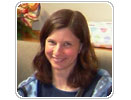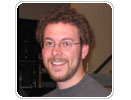 |
 |
 |

|
| :: |
 |
| |
 Bryan
hails from Traverse City, Michigan where the dark sky enthralled
him from a very early age and
inspired him to study astronomy. He graduated from the University
of Michigan in 1997 with degrees in Astronomy, Physics, and
Saxophone Performance. Bryan continued his education at the
University of California at Berkeley, where he researched
the large scale flow of galaxies in the nearby Universe by
measuring their distances. He received a Ph.D. in Astrophysics
from UC Berkeley in 2002. Bryan now works in the SEGway team
to educate and inspire others about the wonder and beauty
of the Universe. His work in space science education and
public outreach involves developing programs for the public
through the Web and museums, developing classroom materials
for students in K-12 classrooms, and conducting professional
development for science educators. Bryan
hails from Traverse City, Michigan where the dark sky enthralled
him from a very early age and
inspired him to study astronomy. He graduated from the University
of Michigan in 1997 with degrees in Astronomy, Physics, and
Saxophone Performance. Bryan continued his education at the
University of California at Berkeley, where he researched
the large scale flow of galaxies in the nearby Universe by
measuring their distances. He received a Ph.D. in Astrophysics
from UC Berkeley in 2002. Bryan now works in the SEGway team
to educate and inspire others about the wonder and beauty
of the Universe. His work in space science education and
public outreach involves developing programs for the public
through the Web and museums, developing classroom materials
for students in K-12 classrooms, and conducting professional
development for science educators.
:: Return to Top
|
|
 |
 |
 |
| |
 In sixth grade, a substitute teacher shared
the joys of astronomy with Laura Peticolas and her class.
With her parents as scientists, it was an easy decision to
start studying to be an astronomer. Many years later, in
1994, she received her Bachelor of Arts from the University
of Oregon Honors College in Math and Physics. In August,
2000, she received a Ph.D. in Physics from the University
of Alaska in Fairbanks, after studying how auroral electrons
caused the light of a specific type of aurora known as flickering
aurora. In addition to performing science research on the
aurora, she works to share NASA science with students, teachers,
and the public. This work involves many diverse projects
from designing lessons around physics concepts important
in space physics discoveries to working with the Berkeley
music department to map solar wind data to music. In sixth grade, a substitute teacher shared
the joys of astronomy with Laura Peticolas and her class.
With her parents as scientists, it was an easy decision to
start studying to be an astronomer. Many years later, in
1994, she received her Bachelor of Arts from the University
of Oregon Honors College in Math and Physics. In August,
2000, she received a Ph.D. in Physics from the University
of Alaska in Fairbanks, after studying how auroral electrons
caused the light of a specific type of aurora known as flickering
aurora. In addition to performing science research on the
aurora, she works to share NASA science with students, teachers,
and the public. This work involves many diverse projects
from designing lessons around physics concepts important
in space physics discoveries to working with the Berkeley
music department to map solar wind data to music.
:: Return to Top
|
|
 |
 |
 |
| |
 An
avid Legos player as a tomboy, Darlene unwittingly enjoyed
the wonders of science as she took apart her mother’s phones
and built strange contraptions that lofted G.I.Joes high
up in the air. Despite this early affinity for physics, she
graduated from the University of California, Berkeley in
2001 with a Bachelor of Arts in Rhetoric and a minor in English.
Yet Fate was kind enough to return Darlene to her youthful
awe of figuring out how things work, and opening her mind
and lifelong learning to the fields of astronomy, space weather,
and solar physics. Now she works in the SEGWay team, helping
to pass space science education to K-12 teachers, their students,
and the general public, with much of the same enthusiasm
inspired by her childhood toys. An
avid Legos player as a tomboy, Darlene unwittingly enjoyed
the wonders of science as she took apart her mother’s phones
and built strange contraptions that lofted G.I.Joes high
up in the air. Despite this early affinity for physics, she
graduated from the University of California, Berkeley in
2001 with a Bachelor of Arts in Rhetoric and a minor in English.
Yet Fate was kind enough to return Darlene to her youthful
awe of figuring out how things work, and opening her mind
and lifelong learning to the fields of astronomy, space weather,
and solar physics. Now she works in the SEGWay team, helping
to pass space science education to K-12 teachers, their students,
and the general public, with much of the same enthusiasm
inspired by her childhood toys.
:: Return to Top
|
|
 |
 |
 |
| |
 Igor hails from Moscow, Russia. After getting the astronomy bug as a kid, he’s been an avid amateur astronomer since. Before his arrival in the US he’s been on multiple astronomy related trips as part of a club, including one to see a total solar eclipse. While studying astronomy at UC Berkeley, he started working as a programmer for the Center for Science Education at Space Sciences Laboratory. He’s been a member of the team since 1996. In addition to handling all of the computing needs of the group, he enjoys participating in public outreach events. You will usually find him with one of his telescopes at such events. He is also an amateur astrophotographer. Igor hails from Moscow, Russia. After getting the astronomy bug as a kid, he’s been an avid amateur astronomer since. Before his arrival in the US he’s been on multiple astronomy related trips as part of a club, including one to see a total solar eclipse. While studying astronomy at UC Berkeley, he started working as a programmer for the Center for Science Education at Space Sciences Laboratory. He’s been a member of the team since 1996. In addition to handling all of the computing needs of the group, he enjoys participating in public outreach events. You will usually find him with one of his telescopes at such events. He is also an amateur astrophotographer.
:: Return to Top |
|
 |
 |
 |
| |
 Dr. Craig has retired, but as the founding SEGway program director, she was a research astronomer with more than 10 years involvement with the Experimental Astrophysics Group at the Space Sciences Laboratory. Dr. Craig worked for both the EUVE and the ORFEUS missions, specializing in ground-based observations for studies of late-type stars, cataclysmic variables, white dwarfs, and the local interstellar medium. During the last five years of her time at UC Berkeley, she has worked as the Director of the SEGway Project and Lead Education and Public Outreach (E/PO) Scientist for numerous NASA missions, including FAST, RHESSI, CHIPS, STEREO/IMPACT and THEMIS. Dr. Craig was responsible for designing and implementing overarching themes for K-12 science education and contributed to the dissemination and expansion of the E/PO programs at the national level. She has a Bachelor of Science degree in Math with a minor in Astronomy from Ankara University, Turkey; a Master of Science from Swarthmore College, Pennsylvania, in Astronomy as a Fulbright scholar; and Dr. of Science from University of Trieste, Italy, in Physics with special focus in Astrophysics. Dr. Craig has retired, but as the founding SEGway program director, she was a research astronomer with more than 10 years involvement with the Experimental Astrophysics Group at the Space Sciences Laboratory. Dr. Craig worked for both the EUVE and the ORFEUS missions, specializing in ground-based observations for studies of late-type stars, cataclysmic variables, white dwarfs, and the local interstellar medium. During the last five years of her time at UC Berkeley, she has worked as the Director of the SEGway Project and Lead Education and Public Outreach (E/PO) Scientist for numerous NASA missions, including FAST, RHESSI, CHIPS, STEREO/IMPACT and THEMIS. Dr. Craig was responsible for designing and implementing overarching themes for K-12 science education and contributed to the dissemination and expansion of the E/PO programs at the national level. She has a Bachelor of Science degree in Math with a minor in Astronomy from Ankara University, Turkey; a Master of Science from Swarthmore College, Pennsylvania, in Astronomy as a Fulbright scholar; and Dr. of Science from University of Trieste, Italy, in Physics with special focus in Astrophysics.
|
|
 |
 |
 |
 |
 |
 |
 |
 |
 |
|
 |
 |
|
 |




